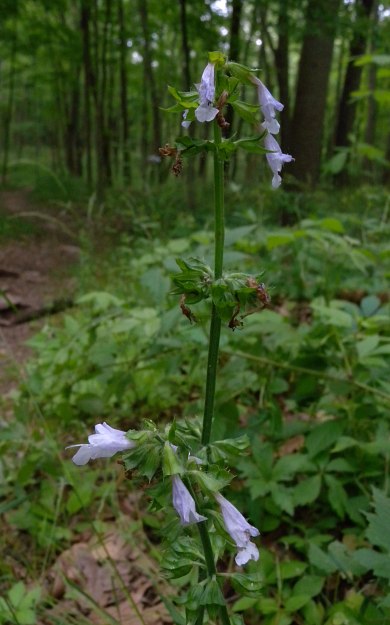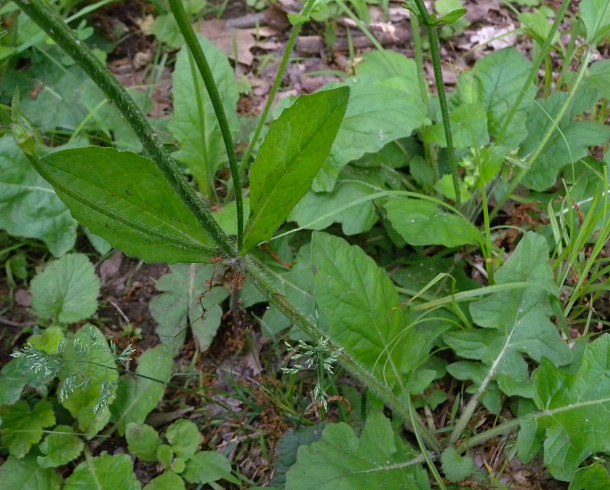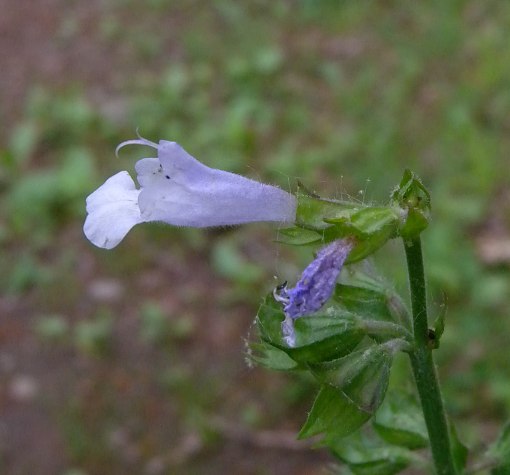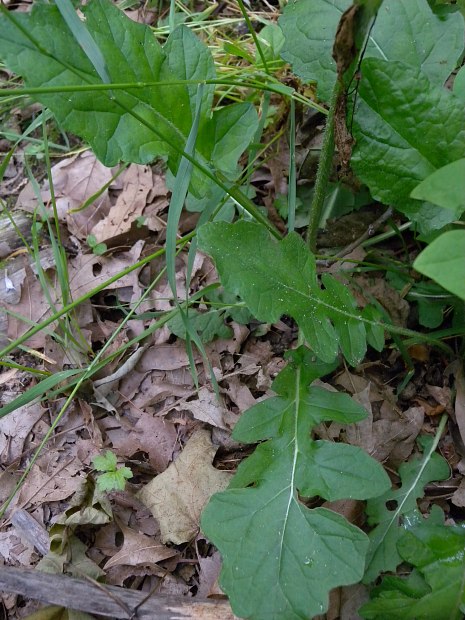
The flowering stalk is light to medium green, sparsely to moderately hairy, and 4-angled. Along the lower one-half of its length, there are 0-2 pairs of opposite leaves (usually a single pair). The opposite leaves are 1–3" long, ¼–1" across, and sessile (or nearly so); they are elliptic to broadly elliptic in shape or, less often, shallowly pinnatifid. The margins of the opposite leaves are either toothless or they may have blunt dentate teeth. The leaf surfaces of both basal and opposite leaves are medium to dark green, sometimes with purplish coloration; they are sparsely hairy. Leaf venation is pinnate. The inflorescence consists of a spike-like raceme of whorled flowers about ½–1½' long; the whorls of flowers are remotely spaced along the central stalk, and there are 4-12 flowers per whorl (typically about 6). Each flower is about ¾–1" long, consisting of a light blue-violet or lavender corolla, a medium green calyx, 2 fertile stamens and 2 infertile residual stamens, a slender style with a bifurcated tip, and a 4-celled ovary.

The corolla is tubular-funnel shaped (widest at its mouth, tapering gradually toward its base) and two-lipped. The upper lip is smaller in size and divided into 3 rounded lobes (1 upper lobe and 2 lateral lobes), while the lower lip is larger in size, slightly notched, and often whitish. The 2-lipped calyx has 3 small upper teeth that are little more than awns and 2 larger lower teeth that taper into awn-like tips; the entire calyx is angular-ribbed and wider at its mouth than its base. The outer surface of the corolla has sparse fine pubescence, while the outer surface of the calyx is sparsely hairy. The pedicels of the flowers are less than ¼" long and pubescent. The blooming period occurs from mid-spring to early summer, lasting about 1 month. Afterwards, each flower is replaced by 4 dark brown to black nutlets that are about 2 mm. in length. and ovoid in shape. The root system consists of a shallow crown with coarse fibrous roots.
Cultivation: The preference is full sun to light shade, moist to dry-mesic conditions, and soil containing sand, rocky material, or gravel. However, ordinary garden soil containing loam or clay-loam is acceptable if competition from taller plants is eliminated or reduced. Northern ecotypes of this plant are more likely to be winter-hardy in colder regions.

Range & Habitat: Lyre-leaved Sage (Salvia lyrata) is occasional in southern Illinois, where it is native (see Distribution Map). Illinois lies along the northwestern range-limit of this plant. Habitats include upland woodlands in rocky areas, areas adjacent to woodland paths, rocky semi-wooded slopes, upland savannas, edges and upper slopes of bluffs, limestone or sandstone glades, sandbars and gravel bars along rivers, semi-shaded roadsides, and pastures. This plant is sometimes cultivated in flower gardens, especially cultivars with purplish foliage. Outside of the state, Lyre-leaved Sage is often found in sandy habitats. In Illinois, it is found in both high quality habitats and more degraded sites.
Faunal Associations: Smith et al. (2012) observed large carpenter bees (Xylocopa), leaf-cutting bees (Megachile), and mason bees (Hoplitis, Osmia) visiting the flowers (probably for nectar). Mourning Doves eat the seeds (Lewis, 1993). The foliage of this plant is probably avoided as a food source by most mammalian herbivores. It is possible that the awn-like tips of the calyces may cling to the fur of mammals, dispersing the seeds to new areas.

Photographic Location: Along a woodland path at the Portland Arch Nature Preserve in west-central Indiana.
Comments: Except for Wild Blue Sage (Salvia azurea), Lyre-leaved Sage (Salvia lyrata) is the only native sage (Salvia) in Illinois. All of the others are either adventive from areas further to the west, or they were introduced from abroad as ornamental plants and culinary herbs. Lyre-leaved Sage is remarkable for the variability of its basal leaves. Because other sages and similar species in the Mint family in Illinois have mostly opposite leaves, rather than basal leaves, it is relatively easy to identify. Another common name of this plant is Cancer Weed.